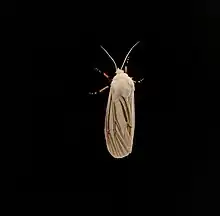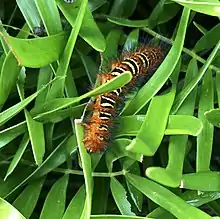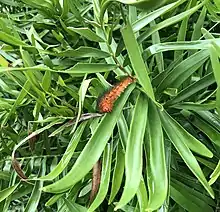Seirarctia
Seirarctia is a monotypic moth genus in the subfamily Arctiinae erected by Alpheus Spring Packard in 1864. Its single species, Seirarctia echo, the echo moth, was first described by James Edward Smith in 1797. It is found in North America, where it has been recorded from Georgia, Florida, Alabama and Mississippi.[1] The habitat consists of thickets, scrubwoods and open areas.

| Seirarctia | |
|---|---|
| Scientific classification | |
| Kingdom: | |
| Phylum: | |
| Class: | |
| Order: | |
| Family: | |
| Subfamily: | |
| Tribe: | |
| Genus: | Seirarctia Packard, 1864 |
| Species: | S. echo |
| Binomial name | |
| Seirarctia echo (J. E. Smith, 1797) | |
| Synonyms | |
| |
The wingspan is about 45 mm.[2]
The larvae feed on various woody plants, including coontie, cabbage palmetto, crotons, lupine, oak and persimmon. They are bright orange with black and yellow bands and bright white spiracles.[3]
Caterpillars


At Stetson University's DeLand, FL campus, many of the Seirarctia echo can be seen in their caterpillar stage. Colloquially referred to as "Haterpillars[4]" (a reference to the school mascot), these caterpillars are well known by students due to their frequent sightings in the summer, fall, and late spring. Although less frequent, the moths are also occasionally spotted.
References
- Savela, Markku. "Seirarctia Packard, 1864". Lepidoptera and Some Other Life Forms. Retrieved September 28, 2019.
- "930308.00 – 8130 – Seirarctia echo – Echo Moth – (Smith, 1797)". North American Moth Photographers Group. Mississippi State University. Retrieved September 28, 2019.
- Tony-2 (July 24, 2018). "Species Seirarctia echo - Echo Moth - Hodges#8130". BugGuide. Retrieved September 28, 2019.
- Stetson University [@StetsonU] (March 12, 2013). "They're baaaaack... Spring's here! #spring #caterpillar #caterpillars #hatterpillar #hatterpillars @… t.co/IYqeSJ44I4" (Tweet). Retrieved June 14, 2021 – via Twitter.
- Pitkin, Brian & Jenkins, Paul. "Search results Family: Arctiidae". Butterflies and Moths of the World. Natural History Museum, London.